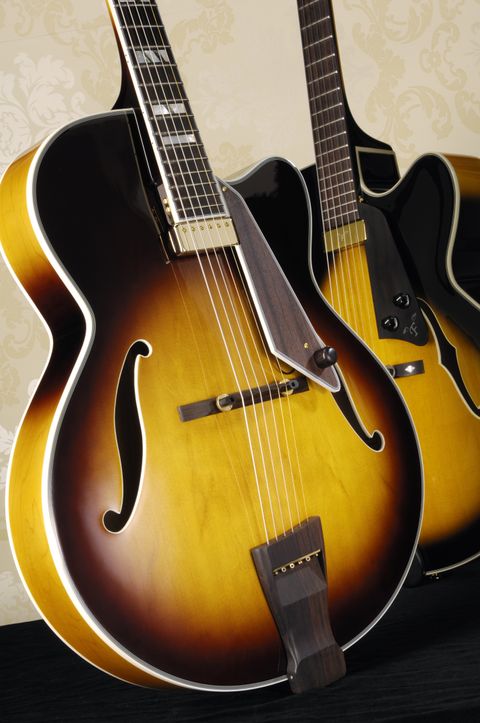Often referred to as the 'jazz guitar', archtops were some of the first instruments to be fitted with magnetic pickups, and can reasonably claim their place among the granddaddies of the modern electric guitar.
First fitted with 'fixed' and then 'floating' pickups, we chose the floating variety which found favour with the likes of jazz greats Wes Montgomery, Herb Ellis and Jim Hall, who all had their own very individual way of interpreting the unique and airy sound texture.
With more archtops available now than ever before, and with nearly all the major companies turning out at least one model in their ranges, we take a look at a couple of the most recent offerings - one from China, the other from Korea - to see if these new pretenders can really capture that authentic jazz vibe and, more importantly, 'that' sound.
Overview
The FJ1 is very square shouldered, with a larger-than-normal upper bout for an archtop.
The top is made from choice grade solid Sitka spruce, while the back and sides are fashioned from quality maple with a classy cream binding and black double carriage purfling.
The traditional f-holes are cleanly cut and, like the body, are finished in cream binding. Interestingly, inside the body the parallel bracing has scalloped edging, which is usually found on more expensive archtops.
The solid ebony tailpiece carries a cut-out 'f', while the delicately fashioned and intonated ebony bridge is fully adjustable with decorative abalone motifs applied to the feet.
The three-piece maple set-neck is modelled on the traditional deep 'U' profile of many a Gibson jazzer.
However, the unusually wide (46mm) nut and the spartan, lightly cambered, 20-fret rosewood fingerboard are not at all typical of the jazz style.
That said, many a large hand will be relieved at the extra room and Django would probably have loved it!
Binding to the fingerboard comes almost unnoticed, as it matches the rosewood board, but thankfully the cream position dots provide more visual contrast and the frets themselves are tidily finished.
The simple Freshman headstock is, like the body, bound with a classy cream binding and black double carriage purfling, and sports the six individual Kluson-style tuners with their opalite 'tulip' heads. Finishing throughout is light and uniform.
The Freshman floating gold humbucker is screwed into the end of the neck with simple tone and volume controls mounted, rather awkwardly, on a shortened solid ebony pickguard. Doesn't every archtop have its quirks?
Sounds
Strung with a set of flat-wound D'Addario 0.012s, acoustically the FJ1 has a sweet and warm tone (akin to many Japanese-made archtops) that is particularly evident in chordal work with a rich bottom end and a clean, clear treble.
Balance is excellent across the full range of the instrument with good articulation, great separation and crystal clear harmonics which could be found all over the fingerboard.
Amplifying the FJ1 does, however, bring a few surprises. After so much acoustic potential it's disappointing to find that the Freshman pickup sounds rather flat, lifeless and ultimately uninspiring.
Lacking any real character, it delivers a clean, clinical response that in no way extends the potential or reflects the true acoustic qualities of this instrument.
Although, as you might expect, the overall tone is warm and mellow, there is no bite and very little depth or width to the sound.
Adjusting the tone knob brings little change, although the volume pot is smoothly tapered and doesn't suddenly wake up at 11 o'clock!
This guitar is an excellent example of the jazz archtop. While it might not sound like the instruments of the '30s and '40s - we wouldn't expect it to - it has its own unique voice with plenty to offer the jazz player.

